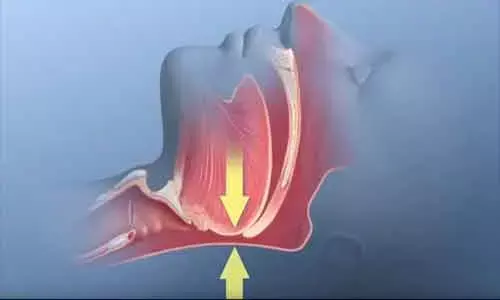- Home
- Medical news & Guidelines
- Anesthesiology
- Cardiology and CTVS
- Critical Care
- Dentistry
- Dermatology
- Diabetes and Endocrinology
- ENT
- Gastroenterology
- Medicine
- Nephrology
- Neurology
- Obstretics-Gynaecology
- Oncology
- Ophthalmology
- Orthopaedics
- Pediatrics-Neonatology
- Psychiatry
- Pulmonology
- Radiology
- Surgery
- Urology
- Laboratory Medicine
- Diet
- Nursing
- Paramedical
- Physiotherapy
- Health news
- Fact Check
- Bone Health Fact Check
- Brain Health Fact Check
- Cancer Related Fact Check
- Child Care Fact Check
- Dental and oral health fact check
- Diabetes and metabolic health fact check
- Diet and Nutrition Fact Check
- Eye and ENT Care Fact Check
- Fitness fact check
- Gut health fact check
- Heart health fact check
- Kidney health fact check
- Medical education fact check
- Men's health fact check
- Respiratory fact check
- Skin and hair care fact check
- Vaccine and Immunization fact check
- Women's health fact check
- AYUSH
- State News
- Andaman and Nicobar Islands
- Andhra Pradesh
- Arunachal Pradesh
- Assam
- Bihar
- Chandigarh
- Chattisgarh
- Dadra and Nagar Haveli
- Daman and Diu
- Delhi
- Goa
- Gujarat
- Haryana
- Himachal Pradesh
- Jammu & Kashmir
- Jharkhand
- Karnataka
- Kerala
- Ladakh
- Lakshadweep
- Madhya Pradesh
- Maharashtra
- Manipur
- Meghalaya
- Mizoram
- Nagaland
- Odisha
- Puducherry
- Punjab
- Rajasthan
- Sikkim
- Tamil Nadu
- Telangana
- Tripura
- Uttar Pradesh
- Uttrakhand
- West Bengal
- Medical Education
- Industry
CPAP help increase physical activity in sleep apnea with heart disease: Study

DARIEN, IL - A new study found that treating obstructive sleep apnea with CPAP therapy increased self-reported physical activity in adults with a history of heart disease.
During a mean follow-up period of 3.7 years, the group treated with CPAP therapy reported approximately 20% higher levels of moderate physical activity compared with the control group. The study also found the CPAP group was more likely to report activity levels consistent with expert recommendations.
"We were pleased to find that our CPAP users reported that they were better able to maintain their levels of activity over the four years of the study, and that they reported fewer limitations in moderate and vigorous activities including those that are important for independent aging, like walking up the stairs," said study co-author Kelly Loffler, who has a doctorate in biochemistry and molecular biology and is a research fellow at the Adelaide Institute for Sleep Health at Flinders University in Adelaide, South Australia.
The study is published in the February issue of the Journal of Clinical Sleep Medicine.
Nearly 30 million adults in the U.S. have obstructive sleep apnea, a chronic disease that involves the repeated collapse of the upper airway during sleep. Common warning signs include snoring and excessive daytime sleepiness. A common treatment is CPAP therapy, which uses mild levels of air pressure, provided through a mask, to keep the throat open during sleep.
The Sleep Apnea cardioVascular Endpoints (SAVE) study was an international, randomized controlled trial of patients with a history of cardiovascular disease and sleep apnea who were recruited from diverse socioeconomic and health care settings. This analysis examined activity data among 2,601 participants between the ages of 45 and 75 years. More than 80% of participants were men, about 63% were Asian, and 25% were white.
Participants were randomly assigned to one of two groups: One group was treated with CPAP and usual cardiovascular care, while a second group received only usual care. While there was no specific exercise intervention, participants reported physical activity using the Leisure-Time Exercise Questionnaire at the start of the study and over six, 24 and 48 months.
According to the authors, the increased level of physical activity found in this study would likely convey substantial health benefits over longer periods of time, such as lowering the recurrence of cardiovascular events.
"CPAP represents a useful tool to assist health care providers caring for populations with comorbidities and combined with lifestyle interventions like diet and targeted exercise will likely provide many users with a symptomatic benefit that goes beyond their reported sleep," said Loffler.
https://jcsm.aasm.org/doi/10.5664/jcsm.8792
Hina Zahid Joined Medical Dialogue in 2017 with a passion to work as a Reporter. She coordinates with various national and international journals and association and covers all the stories related to Medical guidelines, Medical Journals, rare medical surgeries as well as all the updates in the medical field. Email: editorial@medicaldialogues.in. Contact no. 011-43720751
Dr Kamal Kant Kohli-MBBS, DTCD- a chest specialist with more than 30 years of practice and a flair for writing clinical articles, Dr Kamal Kant Kohli joined Medical Dialogues as a Chief Editor of Medical News. Besides writing articles, as an editor, he proofreads and verifies all the medical content published on Medical Dialogues including those coming from journals, studies,medical conferences,guidelines etc. Email: drkohli@medicaldialogues.in. Contact no. 011-43720751


